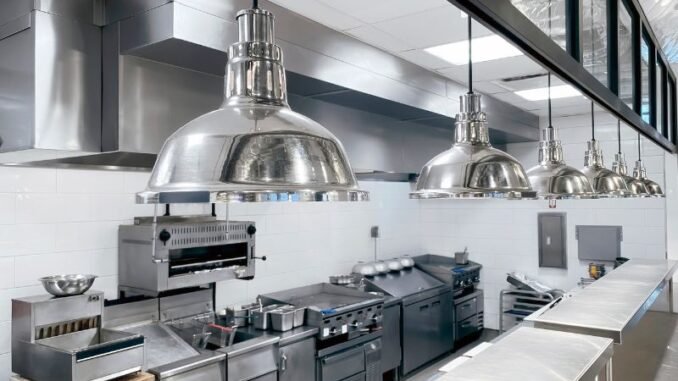
Running a successful food and beverage business starts long before the first customer walks through the door. Behind every great dish is a well-organized kitchen equipped with the right tools to deliver consistency, safety, and speed. Whether you’re opening a café, restaurant, or catering operation, understanding commercial kitchen equipment is one of the smartest investments you can make for your business.
Why Commercial Kitchen Equipment Matters
In the fast-paced F&B industry, your kitchen is more than just a workspace—it’s the engine that drives your operations. The quality, efficiency, and reliability of your equipment directly impact your food quality, labor costs, and profit margins. A well-equipped kitchen reduces downtime, improves workflow, and supports compliance with food safety standards.
Choosing the right equipment isn’t only about buying the most advanced or expensive machines; it’s about finding solutions that suit your menu, volume, and space. Poor choices often lead to unnecessary maintenance costs or workflow bottlenecks that can slow down your entire team.
Core Categories of Commercial Kitchen Equipment
Every professional kitchen, regardless of size or cuisine, relies on a set of essential tools — but what counts as “core” depends on your business model. A full-service restaurant will prioritize heavy cooking and dishwashing equipment, while a café, bakery, or beverage outlet may focus more on refrigeration, prep, and display systems.
Below are the main equipment categories found across the foodservice industry, which you can adapt to your specific operation:
1. Cooking Equipment
This includes your main production tools—ranges, ovens, fryers, and grills. These are the workhorses of any kitchen. For example, a bakery may prioritize convection ovens, while a steakhouse might invest in high-performance charbroilers. Quality cooking equipment ensures consistent heat and performance even during peak hours.
2. Refrigeration and Freezing
From reach-in refrigerators to under-counter chillers and blast freezers, proper cold storage maintains food safety and reduces waste. When choosing, consider capacity, energy efficiency, and ease of maintenance. In hot climates or high-volume kitchens, reliable refrigeration can make or break your operation.
3. Food Preparation Equipment
Mixers, slicers, processors, and blenders speed up prep work while maintaining precision and hygiene. The right prep tools reduce manual labor and keep your workflow smooth during rush periods.
4. Dishwashing and Cleaning
Efficient dishwashing systems—such as undercounter, hood-type, or conveyor dishwashers—keep your operations running without delay. Don’t overlook sinks, waste management systems, and sanitizing equipment; hygiene compliance is non-negotiable in any foodservice environment.
5. Storage and Handling
From shelving units to food bins and trolleys, storage equipment ensures that your ingredients and utensils are organized and accessible. Good layout planning reduces unnecessary movement and enhances kitchen safety.
6. Beverage and Bar Equipment
For cafés and bars, coffee machines, blenders, ice makers, and dispensers are essential. The right beverage setup improves service speed and customer satisfaction—especially in establishments with high drink turnover.
How to Choose the Right Equipment
When selecting kitchen equipment, start with your menu and volume forecast. The dishes you serve and the number of customers you expect determine what tools are essential.
Next, evaluate your kitchen layout. Equipment size and placement affect your staff’s workflow, ventilation, and safety. Consult your chef or kitchen designer early to ensure a logical flow from prep to cooking to service.
Your kitchen layout is just as important as your equipment list. Work concurrently with your equipment supplier when planning — certain machines require specific placements for optimal performance and safety. For example, display showcases shouldn’t sit directly under air-conditioning vents, as condensation and temperature fluctuations can affect product quality. Early coordination ensures proper ventilation, electrical points, and workflow alignment before installation.
You should also weigh energy efficiency and maintenance costs. While premium equipment might come with a higher upfront price, it often pays off through reduced energy bills and longer lifespan. Always check for local after-sales support and availability of spare parts.
Compliance and Safety Considerations
Health and safety regulations vary by region, but every F&B operator must comply with food hygiene, ventilation, and fire safety standards. Invest in equipment that meets certification requirements such as NSF, CE, or HACCP compliance. Regular maintenance and staff training are equally crucial to prevent accidents and ensure consistent quality.
Budgeting and Long-Term Planning
Setting up a commercial kitchen can be a major expense, but smart planning helps control costs. Separate your purchases into “must-haves” and “nice-to-haves.” Start with critical items that support your core menu, then gradually upgrade or expand as your business grows.
Consider leasing or renting options for specialized equipment, especially if you’re testing a new concept. Some suppliers offer rent-to-own programs that let you upgrade later without heavy upfront investment.
Keeping Up with Foodservice Technology
The world of commercial kitchens is evolving fast. From smart ovens that track cooking cycles to energy-efficient dishwashers and IoT-enabled refrigeration, technology is shaping the future of F&B operations. Staying informed about new trends allows you to stay competitive, reduce waste, and optimize labor.
Final Thoughts
Choosing the right commercial kitchen equipment is not just a purchase—it’s a strategy. The right tools empower your staff, elevate your food quality, and streamline your operations. As your business grows, your kitchen should evolve with it—adapting to new trends, technologies, and customer expectations.
Whether you’re outfitting your first kitchen or upgrading an existing one, this guide serves as your foundation. Start with what you need, plan for growth, and always invest in reliability.
Leave a Reply